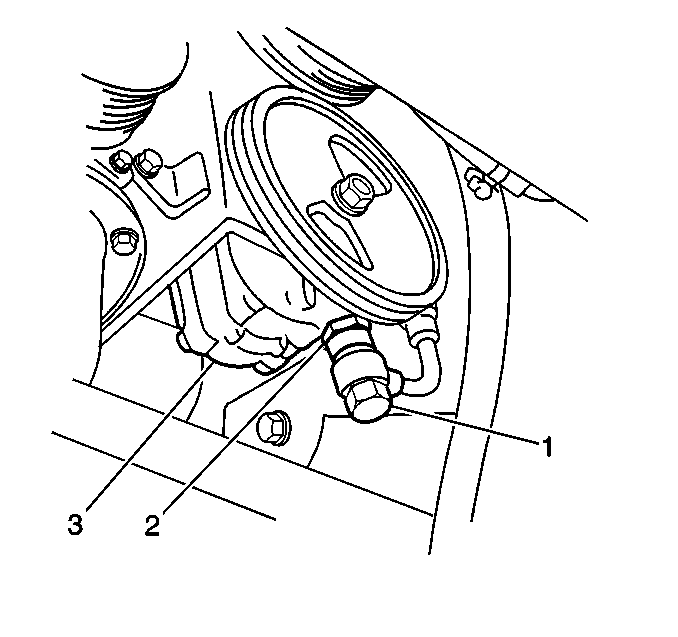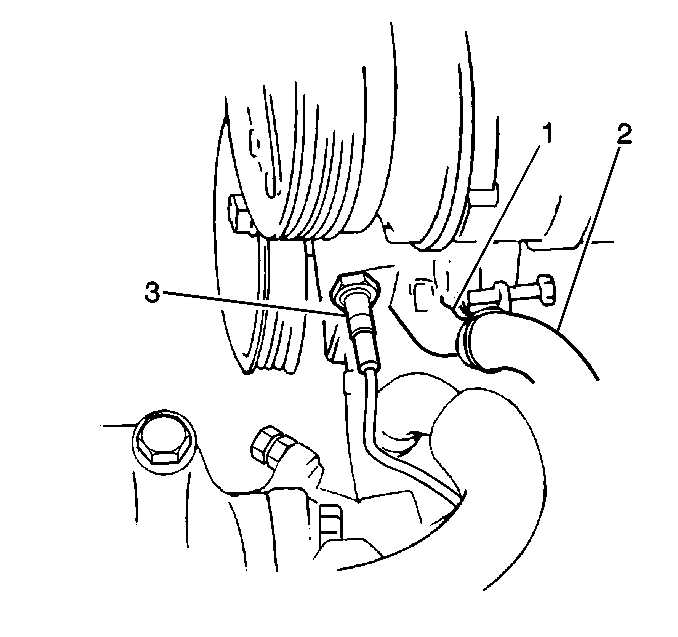Removal Procedure
- Disconnect the negative battery cable.
- Use the following procedures in order to remove the drive belt from the power steering pump pulley:
- Raise and suitably support the vehicle. Refer to Lifting and Jacking the Vehicle in General Information.
- Remove the 4 bolts from the engine skid plate, if equipped.
- Remove the engine skid plate, if equipped, from the vehicle.
- Remove the union bolt (1) from the pressure hose in order to remove the pressure hose from the power steering pump (3).
- Loosen the hose clamp in order to remove the suction hose (2) from the power steering pump.
- Remove the electrical connector (3) from the power steering pump pressure switch.
- Place a drain pan under the engine oil filter in order to catch any escaping oil.
- Remove the engine oil filter.
- Remove the mounting bolts from the power steering pump and the bracket.
- Remove the power steering pump from the vehicle.
Notice: Do not start the vehicle with any power steering gear inlet or outlet hoses disconnected. When disconnected, plug or cap all openings of components. Failure to do so could result in contamination or loss of power steering fluid and damage to the system.
Caution: Unless directed otherwise, the ignition and start switch must be in the OFF or LOCK position, and all electrical loads must be OFF before servicing any electrical component. Disconnect the negative battery cable to prevent an electrical spark should a tool or equipment come in contact with an exposed electrical terminal. Failure to follow these precautions may result in personal injury and/or damage to the vehicle or its components.
| • | If the vehicle is equipped with air conditioning, loosen the compressor mounting bolts. |
| • | If the vehicle is not equipped with air conditioning, loosen the power steering pump mounting bolts. |


Installation Procedure
- Install the power steering pump to the mounting bracket.
- Secure the power steering pump with the mounting bolts. Do not fully tighten the bolts.
- Install the engine oil filter.
- Install the electrical connector (3) to the pump pressure switch.
- Install the suction hose (2) to the power steering pump.
- Secure the suction hose with the hose clamp.
- Install the pressure hose to the power steering pump (3).
- Secure the pressure hose with the union bolt (1).
- Install the engine skid plate, if equipped.
- Secure the engine skid plate with the 4 bolts.
- Lower the vehicle.
- Install the drive belt to the power steering pump pulley.
- Adjust the power steering pump drive belt tension. Refer to Drive Belt Replacement in Engine Mechanical -1.6L.
- Connect the negative battery cable.
- Add power steering fluid to the reservoir. Refer to Checking and Adding Power Steering Fluid .
- Bleed the power steering system. Refer to Power Steering System Bleeding .
- Check the engine oil level. Add oil if needed.


Notice: Use the correct fastener in the correct location. Replacement fasteners must be the correct part number for that application. Fasteners requiring replacement or fasteners requiring the use of thread locking compound or sealant are identified in the service procedure. Do not use paints, lubricants, or corrosion inhibitors on fasteners or fastener joint surfaces unless specified. These coatings affect fastener torque and joint clamping force and may damage the fastener. Use the correct tightening sequence and specifications when installing fasteners in order to avoid damage to parts and systems.
Tighten
Tighten the power steering pump pressure hose union bolt to 40 N·m
(29 lb ft).
Tighten
Tighten the engine skid plate bolts to 27 N·m (20 lb ft).
